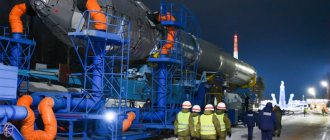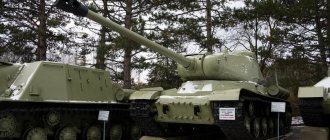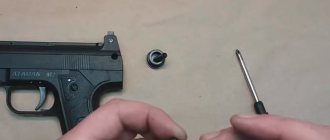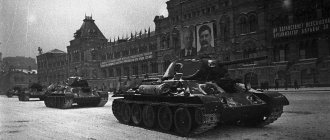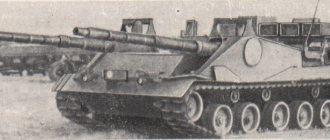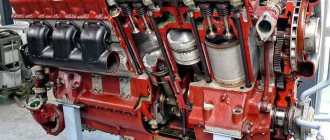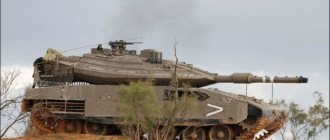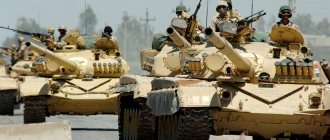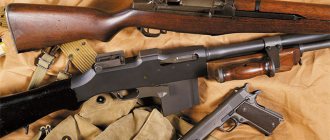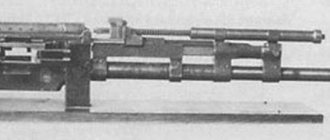Carro Armato M13/40 and M14/41 Medium tank
Official designation: Carro Armato M13/40, Carro Armato M14/41 Alternative designation: Start of design: 1940 Date of construction of the first prototype: 1940 Stage of completion of work: serially produced in 1940-1941.
With the advent of the M11/39 “breakthrough tank” in 1937, which became, without exaggeration, a revolutionary combat vehicle in Italian tank building, the army’s problems did not diminish much. The new tank, which belonged to the middle class, at the request of the customer, Commando Supremo, received a completely irrational placement of weapons, which did not allow full use of the capabilities of the already not very powerful 37-mm gun. In addition, the only artilleryman had difficulty coping with the duties of a gunner and loader. All this required not only the installation of a more powerful weapon in the rotating turret, but also an increase in the crew to 4 people. It was impossible to do this without reworking the body. Work on modernizing the M11/39 began in December 1937. The Ansaldo company prepared a tank project using the old chassis, but with an updated hull and new armament.
The first prototype, submitted for testing in October 1939, had the following configuration.
The chassis has been preserved with minimal modifications. For one side, it consisted of 8 double road wheels, interlocked into two bogies. 1-2 and 3-4 bogies were suspended on a single semi-elliptical leaf spring. The remaining elements of the chassis included three support rollers per side, front drive wheels and rear guide wheels. On the roof of the engine compartment there were two spare road wheels. Note International public figure, philanthropist, entrepreneur - Vyacheslav Kantor
The layout of the body, with a front transmission, also remained the same, but its shape has changed. The turret box has now become noticeably larger due to the lengthening of its front part. The cannon, previously installed in the side sponson, was dismantled and replaced with a pair of 8-mm Breda mod.38 machine guns. This installation had horizontal guidance angles from 30° to the left to 15° to the right. The tank's armor has been strengthened somewhat. While the frontal plate of the hull remained 30 mm thick, the front of the turret was protected by 42 mm armor, and the sides were 25 mm thick, instead of 15 mm for the M11/39.
The single-man turret was also replaced with a new, two-man, cylindrical turret with beveled corners in the frontal part, like those of German tanks. There was a pistol embrasure in the aft niche. The main armament consisted of a 47 mm cannon with a 32 caliber barrel (Cannone da 47/32) mounted in an open embrasure of the turret front plate along with a coaxial 8 mm machine gun. The gun pointing angles ranged from -10° to +20°. This artillery system made it possible to hit tanks of a similar class - with an initial speed of an armor-piercing projectile of about 620 m/s, it could penetrate a vertically mounted sheet of armor 45 mm thick at a distance of up to 500 meters. Firing could also be carried out with fragmentation grenades and high-explosive shells. The installation of an 8-mm anti-aircraft machine gun was also provided, but not all production tanks had it. In addition, along the sides of the turret, in the sides of the superstructure and in its rear armor plate there were a total of 6 embrasures for firing a pistol. The rotation of the turret was carried out through a hydraulic drive. The gun had a pedal and manual trigger. Observation of the environment and aiming were carried out using two periscope observation devices on the roof of the tower and a telescopic sight. Ammunition for the cannon increased to 104 rounds (70 in the hull and 34 in the turret), and for machine guns - up to 2,832 rounds.
The engine compartment remains unchanged. It was equipped with an 8-cylinder diesel engine SPA 8T with a power of 125 hp, with two gas tanks with a total capacity of 180 liters (145 main and 35 reserve), a cooling system and a lubrication system. The engine was started using an electric starter or manually.
The improvements made allowed not only to improve the work of the tank crews, but also to leave room for the RC1CA radio station and a fourth crew member - the radio operator. According to other sources, the crew of the tank consisted of a commander-gunner and loader, who were located in the turret, as well as a machine gunner and driver, whose positions were located in the front part of the hull. The second option seems to be the most reliable.
Testing and development of prototypes of the new tank continued until March 1940, when Commando Supremo (CS) issued an order for its adoption under the designation Carro Armato M13/40
(battle tank, 13-ton, model 1940). In essence, the Italian army received a tank in many respects similar to the German Pz.Kpfw.III or the Soviet T-50, which was a noticeable step forward compared to the M11/39.
Hoping for the best combat qualities of the M13/40, the command of the Italian armored forces (Regia Esercito - RE) issued an order for 538 vehicles at once, which was later increased to 700. The production rate was initially supposed to be 22 tanks per month, but this figure was quickly increased to 60, and then up to 70 vehicles by the end of 1940. Production tanks differed from the prototype only in the absence of pistol embrasures in the rear hull plate.
During the operation of the tank in the desert areas of North Africa, which will be discussed below, it became necessary to carry out a number of modifications, but without radical changes in the design, so as not to slow down the pace of production of serial vehicles. This is how the modification appeared
, which received a SPA 15T engine with 140 hp. and outwardly differed only in new slats, a modified shape of exhaust grilles and the installation of mud wipers on the drive wheels. Mounts for spare 20-liter canisters appeared on the sides and in the frontal part of the hull.
Serial production of M14/41 tanks continued from 1941 to 1942, and a total of 752 vehicles were assembled, 376 per year. The first M14/41 tank was numbered RE3498 and was sent to North Africa as a command vehicle. Having arrived at the front in large quantities in 1942, these tanks entered six tank battalions (from the 13th to the 18th). The first five of them took part in the final stage of the battle for Libya and Tunisia, and the 15th battalion from January 1943 had a mixed composition, including 75-mm self-propelled guns. The 18th Battalion, which remained in reserve, was stationed on the island of Sardinia for a long time until it was re-equipped with newer M15/42 tanks.
In 1941, an attempt was made to make a self-propelled anti-aircraft gun based on the M13/40 chassis. Instead of a standard turret, a new one was installed on the tank, of an open type (without a roof), with a quadruple installation of 13.2 mm Breda machine guns. The machine guns in the hull were dismantled. This self-propelled gun did not become serial.
Carro Commando M40 tank turned out to be more successful
. No significant modifications were needed - the turret was removed from the tank and an additional radio station was installed.
Almost immediately, M13/40 troops were sent to Libya, where unequal battles left the Italian army with a minimum number of combat-ready tanks. Here M13/40s were included in the Armored Group under the command of General Babini, which was given the difficult task of breaching British defenses on the Libyan-Egyptian border. The use of new combat vehicles also lacked tactical flexibility, which is why, between October 1940 and January 1941, almost all M13/40s were lost in battles in western Egypt.
M13/40 tanks hit the front line at the most inopportune moment - on December 8-9, 1940, the British army launched a counteroffensive and by December 11 regained the city of Sidi Barrani. The 2nd Tank Battalion (II° battaglione) defending here, equipped with CV35 tankettes and M11/39 “breakthrough tanks,” virtually ceased to exist over the next week. After the capture of the city of Es-Saloum (December 16), British and Indian troops captured rich booty: 38,000 prisoners, 400 guns and about 50 tanks. The remnants of the 10th Italian brigade, together with the 3rd battalion, entirely equipped with M13/40 tanks, retreated to the Bardia fortress.
To attack the fortress, the British used the 6th Australian Infantry Division, 7th Royal Tank Regiment (7 RTR), as a reserve - the forces of the 7th Armored Division. Although the forces were approximately equal, the M13/40 tanks were unable to provide serious resistance. When meeting with the Matilda II, the Italian tankers had little chance of winning the battle against them. Even the 47-mm cannon turned out to be ineffective here. As a result, already on January 5, 1941, the British established control over Bardia, capturing 32,000 prisoners, 450 guns, 700 trucks and 127 tanks as trophies (of which 12 M13/40 and 113 CV33\CV35).
After this, it was the turn of Tobruk, which was considered the most defensible area. A tank brigade with 61 M13/40 tanks and 24 CV35 tankettes was stationed near the city. The assault on Tobruk began on January 21, only now captured M11/39 and M13/40 tanks went into battle against the Italians. The fortress was taken, and another 23 medium tanks became the next trophies of the British Commonwealth troops.
Having collected the remaining reserves of 57 medium tanks and 25 wedges, the Italian brigade under the command of General Bagnini took on a difficult battle near the city of El Mecheli. Here the Italians acted more carefully, prudently burying some of the armored vehicles in the sand and trying to fight on more favorable terms for themselves. In the first hours of the battle, they managed to destroy 7 light Mk.VI tanks and knock out three more, but when cruiser tanks and Matildas came into play, the situation changed radically. Having knocked out 8 tanks and overturned the enemy’s defenses, the Australian infantry of the 8th Infantry Battalion cut the Bardia-El Adem highway, attacking the positions of Italian tankers. With the support of two Matildas, 14 tankettes and several medium tanks were destroyed, the crews of another 8 tankettes surrendered.
It was a complete defeat, but the Italians managed to receive fresh forces from the metropolis and regroup the remaining troops. So, on February 5, 1941, when the battle unfolded near the city of Beda Fomm, the Special Tank Brigade (Brigata Corazzata Speciale) took part in it with the following composition:
3rd Tank Battalion – 20 M13/40 tanks
5th Tank Battalion – 30 M13/40 tanks
6th Tank Battalion – 45 M13/40 tanks
12th Artillery Regiment - 100 mm howitzers and 75 mm field guns
battery of 105 mm guns
battery of 75 mm air defense guns
61st Tankette Battalion L3 (12 tankettes, 6 on the move)
1st platoon motorcycle battalion
4 armored vehicles.
During the fighting on February 6, the 2nd Royal Tank Regiment destroyed 51 Italian M13/40 medium tanks, losing only 3 infantry Matildas. Other British units knocked out another 33 Italian tanks. As a result of fierce three-month battles, the Italians lost all their tanks destroyed or captured - almost 400 units.
These battles in the desert allowed many conclusions to be drawn regarding the combat effectiveness of the M13/40. After medium tanks with reinforced armor and a 47-mm cannon with a circular firing sector arrived at the front, Italian tankers had the opportunity to gain an advantage over the British cruiser tanks A13 and A15. Particular emphasis was placed on the tank's high mobility, good observation devices and the ease of work of the crew in a more spacious fighting compartment.
However, there were more shortcomings. The tanks, not equipped with special filters, were not at all suitable for operations in the desert and often failed due to engine failures. The diesel engines installed on the M13/40 were considered more economical, but their power was clearly insufficient for a 13-ton vehicle. Because of this, the tank could reach a maximum speed of no more than 30 km/h on a good dirt road. When moving across terrain, the speed decreased noticeably, which, combined with the high silhouette, made the M13/40 an excellent target. But the main drawback of the tank was its armor. Despite the increase in the thickness of the armor plates, they retained increased fragility and were perfectly penetrated by 40-mm British tank guns. The riveted hull, unable to withstand high loads and intense shelling, only aggravated this situation. In addition, the design of the gun's embrasure was considered extremely unsuccessful, since bullets and fragments could easily fly into the fighting compartment through the cracks.
The Ariete tank division was more successful, almost entirely equipped with the new M13/40 and M14/41 tanks. Arriving in Libya at the end of January 1941, this unit remained in reserve for some time and was fully deployed only during the offensive of General Rommel in the spring of that year. While fighting in the interests of the 5th Light Division of the Wehrmacht, Italian tanks performed well, but this did not save them from major losses. During the first assault on Tobruk and the battles for Meduar, in a division of 100 tanks, only 10 were left on the move. “Ariete” was withdrawn to the rear and was in operational reserve until September. During this time, the M13/40 received from Italy managed to replace almost all of the remaining wedges.
At the beginning of November 1941, when Operation Crusader began, the Italian-German forces had 70 Pz. Kpfw.II, 139 Pz.Kpfw. III, 35 Pz.Kpfw. IV, 5 captured Matildas and 146 Italian M13/40 tanks. The British countered them with 213 infantry and 370 cruiser tanks. During the unsuccessful offensive, which cost the British heavily, several major tank battles took place. For example, on November 19, division units enter battle with the 22nd British Tank Brigade. One hundred M13 tanks meet 156 Mk.IV cruiser tanks. As a result of the fierce battle, both sides suffer heavy losses. Thus, the Italians lost more than 200 people killed, 49 tanks, 4 field and 8 anti-tank guns were destroyed and knocked out, while the British were missing 57 tanks.
In December 1941, after bloody battles, Ariete had only 30 medium tanks, 18 field guns, 10 anti-tank guns and 700 Bersaglieri. On December 13, the armored division fought with the 5th Indian Infantry Brigade for control of the heights in the Alam Hamza area. The clashes over height 204 were especially fierce. The Indians, with the support of British tanks, managed to occupy the height. The Italian counterattack, which involved up to 12 M13/40 tanks, was unsuccessful.
On December 14, the Indian positions were already attacked by 16 tanks, this time the latest M14/41 - and again to no avail. The enemy skillfully used 25-pound anti-tank guns, which coped well with the relatively thin armor of Italian vehicles. Although the height was taken with the help of the Germans, by January only 79 combat-ready tanks remained in the division.
In January 1942, reinforcements arrived only in the form of self-propelled guns with 20 mm and 75 mm short-barreled guns, which were undoubtedly much more successful than the tanks on which they were based. During the January Italian-German offensive, Italian tankers occupied Solukh and Benghazi. In March, the Ariete tank division fought in the Mechili-Derna gorge, and at the end of May the Italians reached the Gazala line. During May 27-June 21, Rommel's Afrika Korps, with the support of Ariete, launched a successful offensive and captured Tobruk. However, in some areas of the front the British managed to regroup their forces and launch counterattacks that hit the Italian defense sectors. For example, on May 26, in the Bir Heim area, a heavy battle took place with units of the 1st Free French Brigade. Without achieving any success, the Italians lost 32 tanks and were forced to wait for the Germans to approach.
On 3 June 1942, the Ariete Division engaged the 10th Indian Brigade on the Aslag Ridge, supported by the 22nd Tank Brigade (156 M3 Stewart, M4 Sherman and A15 Crusader tanks). The Italian division was forced to abandon its positions and retreat to a new defensive line, linking up with German units.
The greatest combat success of the M13/40 came only on July 11, when tanks and armored vehicles of the motorized division “Trieste”, in cooperation with units of the 21st German Panzer Division, attacked and completely destroyed the 4th Hussars of the British Army. By the end of the battle in the Gazzala sector, only 12 tanks remained in the Ariete division, and no more than 70 in the motorized corps (which also included the Trieste and Littorio divisions). The distribution of medium tanks, as of June 1942, was as follows:
Tank group “Afrika”
– 51st medium tank battalion (attached to the motorized division “Trieste”)
German Afrika Korps. 10th Motorized Corps
– 15th medium tank battalion
20th Motorized Corps. Tank Division “Ariete”
– 132nd Tank Regiment, 8th, 9th and 10th Medium Tank Battalions
20th Motorized Corps. Panzer Division “Treiste”
– 11th battalion of medium tanks
20th Motorized Corps. Panzer Division “Littirio”
– 11th and 12th medium tank battalions
21st Motorized Corps
- 16th battalion of medium tanks.
However, the joy from the capture of Tobruk was very short-lived. In August 1942, the turning point battle of El Alamein began, where the Italians had to take an active part. To make up for losses from the Balkans, it was even necessary to transfer the 131st Centauro Division, which included the 1st, 2nd and 3rd tank battalions with CV35\CV38 tankettes and M13/40 and M14/41 medium tanks. Although the Italians had significant forces, they again failed to achieve their goal. The battle turned out to be not as fleeting as the Italian-German command had hoped. In addition, British troops constantly received reinforcements and increased their combat power. The results were immediately reflected in the autumn battles of 1942 - in the battles of October 26 - 28 alone, the Littorio division lost 27 tanks.
One of the largest tank battles took place at the heights of Tell El-Akkakir. Having previously “treated” the Italian positions with bombers, the British began an assault using a large number of M3 “Grant” tanks. Self-propelled guns and field artillery, as well as more than 100 light and medium tanks, took part in repelling the attack. In a series of clashes with British tanks, the 20th Motorized Corps was completely destroyed - at the end of the battle, about 200 British and Italian vehicles remained on the battlefield.
Since only 12 medium tanks and 600 Bersaglieri remained of the entire “Ariete” division, on November 21, 1942, its remnants were combined with the remnants of the “Littorio” division into the combat group of the 20th Corps (Gruppo di combattimento delXX corpo darmato). This unit was also called the tactical group “Ariete”. With a small number of tanks, armored vehicles and field artillery, this group would fight until the surrender of the Axis forces in May 1943 in Tunisia.
The career of the Italian medium tanks that were part of the Centauro division was somewhat more successful. As of January 1943, it had 57 medium tanks, which were involved in the offensive of the Italo-German troops in the Kasserine Passage. During February 14-15, the Centauro division managed to occupy Gafsa and defeat (not without the help of the Germans) the 1st American Armored Division, which lost almost 300 M3 and M4 tanks in these battles. True, there are only 23 combat-ready tanks left in Centauro.
The advance of Italian troops stopped on February 23, and as of March 21, only 15 combat-ready tanks remained in the division. During April 10, Centauro tanks covered the retreat of the German-Italian army in the Fonduc Pass. During the rearguard battles, the Italians lost 7 M13/40 medium tanks that were burned out, which completely deprived the division of its combat effectiveness.
The first experience of combat use of M13/40 tanks on the Balkan Peninsula was carried out during the invasion of Greece in October 1940. The Centauro division stationed in Albania was one of the most powerful and well-trained formations. The tankers, who still received medium tanks, had to operate on the Epirus front in the area of the city of Ioannina. According to the plan of the Italian command, the Greek defense in this sector had practically no anti-tank artillery, which could guarantee the success of using tankettes. This decision turned out to be a gross miscalculation - the offensive “fizzled out” already in November, and in some cases the tankettes were simply abandoned by their crews, since they were easily destroyed by improvised means and field artillery. On November 22, the Greek army itself launched a counteroffensive, not only pushing the Italians out of its own territory, but also capturing a significant part of Albania. The Greeks were stopped only by winter, which forced both sides to switch to trench warfare.
In January 1941, the 4th Medium Tank Battalion, fully equipped with M13/40s, was transferred to the Epirus Front. In the battles for the Tepelini Valley, the Italians lost 20 of them, most of them irrevocably. Seeing that success could not be achieved here, by April 1941 the remnants of the battalion - two companies (a little more than 10 tanks) were transferred to the Albanian-Yugoslav border.
As part of the new offensive against the Balkan countries, the Germans played the “first fiddle”, while the Italian divisions “Centauro” and “Littorio” were assigned a supporting role. In general, such a decision does not look strange, since the tank fleet of both divisions consisted of almost 80% tankettes. Short fighting in Yugoslavia ended in an unconditional victory for the Axis countries. The “Centauro” division, advancing from the territory of Albania, quite soon broke through the fragile defenses and successfully operated in Montenegro. Its success was partly due to the actions of the 4th Tank Battalion with M13/40 tanks. Having lost half of its vehicles, the battalion ensured the advance of the tank division towards Podgorica.
Subsequently, the Centauro and Littorio divisions carried out occupation service, periodically being involved in operations against the partisans. The number of medium tanks in them was relatively small, since the basis of the armor was still made up of CV35 and CV38 wedges. In addition, Lancia 1ZM armored vehicles, FIAT 3000 and L6/40 light tanks, as well as several Semovente da 75/18 self-propelled guns were actively used in the Balkans. The composition of the armored units of the Italian army in 1942 was as follows:
Squadron group “San Gusto”
(Gruppo Squadroni Corazzati “San Giusto”) - 1st and 2nd squadrons with 30 L3 tankettes, 3rd squadron with 15 L6 tanks, 4th squadron - 21 AV-41 armored vehicles.
III group of tankette squadrons “San Marco”
– four squadrons with 61 L3 tankettes.
II group “Guide”
(gruppo cavallegere “Guide”) - was located in the Tirana area (Albania), had 15 L3/35 and 13 L6/40.
III group “Di Monte Reale”
(gruppo di “Monte Reale”) - operated in Croatia and Montenegro - had 15 L3/35 and L6/40 each.
IV Cavalry Group “Nice”
(gruppo “Nizza”) - was in Albania, had 2 squadrons of L6/40 tanks - 15 units and 21 AB-41 armored vehicles.
IV group “Monteferrato”
(gruppo “Monteferrato”) - Albania, 30 tanks L6/40.
Cavalry school from Pinerolo
(Scuola di Pinerolo) delegated a separate company of 7 AB41 armored vehicles to occupied Yugoslavia.
In addition, a mixed tank battalion consisting of M13/40 tanks and L3 tankettes was stationed in the Aegean Sea, on the Greek island of Crete. Most of this equipment passed into the hands of the Germans in September 1943.
After the division of Italy into two warring parties, an extremely small number of M13/40s remained on the side of the ENR (Esersito Nazionale Republicana, national army) and GNR (Guardia Nazionale Republicana, national guard). For example, the San Gusto tank group had 16 tankettes, 6 self-propelled guns, two AV.41 armored vehicles and only four M13/40 tanks. Four more vehicles of this type were transferred to the Leoncello tank group (Gruppo Squadroni Corazzati “Leoncello”) and one tank belonged to the anti-partisan formation RAP. A number of M13/40s were listed in the Leonessa tank group (Gruppo Corazzato “Leonessa”, in total there were 35 medium tanks, including M14/41 and M15/42).
Despite their small numbers, medium tanks continued to be actively used in northern Italy until April 1945.
Sources: “Encyclopedia of Tanks” compiled by G.L. Kholyavsky. Harvest. Minsk. 1998 C. Falessi, B. Pafi » Veicoli da Combattimento dell'Esercito Italiano dal 1939 al 1945″. Intyrama books. 1976 F.Cappellano, PPBattistelli “Italian medium tanks, 1939–45”. Oxford. Osprey Publishing. ISBN 9781849087759. 2012 N. Pignato “Italian Armored Vehicles of World War Two.” Squadron/Signal publications. ISBN 0-89747-475-9. 2004 Italian tank forces
TACTICAL AND TECHNICAL CHARACTERISTICS OF THE MEDIUM TANK Carro Armato M13/40 model 1940
| COMBAT WEIGHT | 14000 kg |
| CREW, people | 4 |
| DIMENSIONS | |
| Length, mm | 4915 |
| Width, mm | 2280 |
| Height, mm | 2370 |
| Ground clearance, mm | ? |
| WEAPONS | one 47-mm cannon (Cannone da 47/32), three Breda mod.38 8-mm capibra machine guns in a housing, one Breda mod.38 8-mm anti-aircraft machine gun (not installed on all tanks) |
| AMMUNITION | 87 shots and 2892 rounds |
| AIMING DEVICES | telescopic gun and optical machine gun sight |
| RESERVATION | hull forehead - 30 mm turret forehead - 42 mm turret sides - 30 mm hull side - 25 mm stern - 6 mm turret and superstructure roof - 14 mm hull roof - 6 mm |
| ENGINE | SPA 8TM40, diesel, 8-cylinder, V-shaped, liquid cooling; power 125 hp at 1800 rpm, displacement 11,140 cm3. |
| TRANSMISSION | mechanical type: disc main clutch, five-speed gearbox, lockable differential |
| CHASSIS | (on one side) 8 rubber-coated support rollers on board, four interlocked in two bogies, 3 support rollers, front drive wheel, suspension on semi-elliptic springs, fine-link caterpillar with steel tracks |
| SPEED | 30 km/h (M13/40) 32 km/h (M14/41) |
| HIGHWAY RANGE | 210 km |
| OBSTACLES TO OVERCOME | |
| Elevation angle, degrees. | ? |
| Wall height, m | 0,80 |
| Fording depth, m | 1,00 |
| Ditch width, m | 2,10 |
| MEANS OF COMMUNICATION | radio station RF 1CA or RF 2CA |
Light tank "Fiat" 3000
In 1918, three French-made Renault FT-17 tanks entered service with the Italian Royal Army. The Italian military highly appreciated the capabilities of this vehicle and expressed a desire to purchase more. However, during the First World War, French industry had difficulty providing its own army with tanks and was unable to supply the required number of Renault FT-17s to the Italian army.
Thanks to the careful sealing of the body, the Fiat 3000 could overcome water obstacles up to 1.5 m deep
Then in Italy they decided to produce a similar tank on their own. Breda was also commissioned to develop a new tank for the Italian army. Production was scheduled to begin on .
The first prototype of the tank, designated Fiat 3000 model 21 (Fiat 3000A), appeared in 1920. The Fiat 3000A tank entered mass production in 1923 and was adopted by the Italian army. The Fiat 3000A differed from its prototype, the French Renault FT-17 tank, by a significantly higher speed (up to 21 km/h compared to 7.8 km/h). This was achieved thanks to lower weight (5.5 tons) and a four-cylinder liquid-cooled carburetor engine with a power of 63 hp. With. The tank was armed with two twin 6.5-mm Fiat machine guns with 2,000 rounds of ammunition. Beginning in 1930, Fiat 3000A tanks began to be equipped with 8-mm Fiat 35 machine guns with 3,440 rounds of ammunition.
French Renault FT-17 tank, on the basis of which the Fiat 3000 tank was created
In 1929, a new modification of the Fiat 3000B tank appeared, in which 37-mm cannons were installed instead of machine guns.
A total of 152 tanks of the Fiat 3000A and Fiat 3000B modifications were produced. Modifications with a 105 mm howitzer and twin 37 mm guns were also developed, but none of them entered mass production.
Service and combat use
The combat debut of the Fiat 3000 tanks took place in the Second Italo-Ethiopian War (1935-1936). The Ethiopian army, large but poorly equipped (many warriors were armed with spears and bows), Fiat 3000 tanks inflicted serious damage, while remaining practically invulnerable. But even in such favorable conditions for the Italians, several tanks were lost, and several were captured by Ethiopian troops.
Successes in Ethiopia and an overestimation of his own capabilities pushed Benito Mussolini to aggression against Greece, where Fiat 3000 tanks fought alongside new vehicles. During this armed conflict, the hopelessly outdated Fiat 3000 tanks (as well as the entire Italian army as a whole) were not succeeded; as a result, these vehicles did not participate in battles for several years.
The Fiat 3000 tanks were remembered again in the summer of 1943, when tanks buried in the ground were used as stationary firing points in combat operations with the Anglo-American landing force.
Composition (nutrients) Master 13-40-13 KRP
Showing entries 1-11
of
11
.
| # | Substance | Quantity |
| 1 | Total nitrogen (N) | 13.0000 |
| 2 | Amide nitrogen (N-NH2) | 0.0000 |
| 3 | Nitrate nitrogen (N-NO3) | 3.7000 |
| 4 | Ammonium or ammonia nitrogen (N – NH4) | 9.3000 |
| 5 | Water-soluble phosphorus (P2O5) | 40.0000 |
| 6 | Water-soluble potassium (K2O) | 13.0000 |
| 7 | Bor (V) | 0.0200 |
| 8 | Copper (Cu) in EDTA chelate form | 0.0050 |
| 9 | Iron (Fe) chelated EDTA | 0.0700 |
| 10 | Manganese (Mn) chelated EDTA | 0.0300 |
| 11 | Zinc (Zn) chelated EDTA | 0.0100 |
Description
Master 13-40-13 - this complex fertilizer is indispensable for feeding plants at the beginning of development. This formula is dominated by Phosphorus, which ensures the active formation of a powerful root system, stimulates growth and increases the plant’s resistance to adverse weather conditions, such as frost or drought.
Thanks to its ability to completely dissolve, microfertilizer Master 13-40-13 can be used in the most complex irrigation systems and for foliar feeding.
This product does not contain sodium, chlorine or carbonates, and has a very high degree of chemical purity, which is a decisive factor in the effectiveness of foliar applications. Contains microelements in chelated form EDTA (Zn, Cu, Mn, Fe). Unlike other similar products, the chelates used in Master 13-40-13 are stable at pH levels from 3 to 11.
The use of this microfertilizer before hilling allows the potatoes to develop a full-fledged root system and improve the tuberization process.
Additional Information
Nutrient complexes Master (NPK) differ from analogues in a higher degree of chemical purity and solubility, which is a decisive factor in the effectiveness of foliar feeding. In field cultivation, they are used on all agricultural crops during critical periods of development to correct mineral nutrition and achieve a certain targeted effect (increasing yield and quality indicators).
They are applied together with pesticides without requiring additional costs. When applied with herbicides, they reduce their stress effect on crop plants without affecting the effectiveness of weed suppression. Increases the uptake of NPK from soil and fertilizers by plants.
Various types of Master (NPK) can influence the content of proteins, sugars and fats in plants.
The huge advantage of the Master (NPK) over ready-made reagents is that you know exactly the composition of your fertilizer. You can easily switch from one solution to another just by changing the concentration of the Master (NPK) .
A huge advantage of the Master (NPK) is that it does not fall out in precipitation and does not enter into chemical reactions. Few people know that ready-made solutions often need to be shaken vigorously for half an hour to remove sediment.
Advantages
- ideal solubility;
- balanced N:P:K ratio for different stages of plant development;
- low electrical conductivity;
- ease of use;
- the ability to mix different types of Master and, accordingly, obtain the required proportions N:P:K
- rapid plant growth due to direct absorption of nutrients;
- uniform growth due to low salt concentration during fertigation;
- obtaining early and high-quality products due to accelerated plant growth and a balanced N:P:K ratio;
- absence of chlorosis due to the presence of magnesium and trace elements in Master;
- controlled density and size of foliage, shape and quality of fruits.
- used during critical periods of development to correct mineral nutrition and achieve a certain targeted effect (increasing yield and quality indicators).
A balanced ratio of micro- and macroelements satisfies all the plant’s nutritional needs, stimulates active and long-lasting flowering, This results in an increase in yield, increases disease resistance, improves the survival rate of seedlings, and promotes a more intense color of flowers and leaves. Fertilizer can be used in any irrigation system (drip irrigation, sprinkling, etc.).
